The electronic logging device (ELD) mandate has been part of trucking reality since December 2017. That’s over seven years of truckers adapting to electronic hours of service (HOS). Electronic logs were expected to improve compliance, enhance road safety, and reduce paperwork.
Ask any group of truckers about ELDs, and you’ll hear passionate opinions from both sides. Some drivers appreciate the streamlined inspections and reduced paperwork. Others feel the rigid electronic monitoring has taken away the flexibility that made trucking appealing in the first place.
In this article, we’re going beyond basic compliance questions. You already know you need an electronic logbook—but are you getting everything you could be from your system? Many truckers are discovering that not all ELDs are created equal, and that choosing the right provider can mean the difference between technology that fights you every mile and technology that actually makes your job easier. Whether you’re shopping for your first ELD or if your current provider isn’t meeting your needs, we’ll show you how to make electronic logs work for you instead of against you.
Do you have any questions? Talk to ELD Advisor: 650-405-3372 or Request Callback
Key Trucking Electronic Log Mandate Requirements
The ELD mandate is a federal regulation that requires commercial motor vehicle operators to use electronic logging devices to record their hours of service (HOS), replacing the paper logbooks that drivers had used for decades.
The electronic log mandate for trucks was implemented as part of the Moving Ahead for Progress in the 21st Century Act (MAP-21), with the Federal Motor Carrier Safety Administration (FMCSA) publishing the final ELD rule in December 2015. The compliance deadline was December 18, 2017, with a grandfather period for automatic onboard recording devices (AOBRDs) until December 16, 2019.
The primary goal of the mandate was to create a safer work environment for drivers and make it easier and faster to accurately track, manage, and share records of duty status (RODS) data. The FMCSA estimated that the rule would save lives and prevent injuries resulting from crashes involving large commercial motor vehicles each year.

Key Compliance Requirements
To comply with the ELD mandate, your electronic logging device must:
- Connect directly to your truck’s engine to automatically record driving time and engine power status, vehicle motion status, miles driven, and engine hours.
- Allow the driver to select on-duty, off-duty, or on-duty not driving status.
- Display a record of duty status so drivers can quickly see hours in current day and previous days.
- Provide data in a standardized format that can be transmitted to law enforcement via wireless web services, USB, or Bluetooth.
- Be self-certified by the manufacturer and registered with the FMCSA.
- Be tamper-resistant and include measures to prevent harassment of drivers.
Your ELD must also be able to display certain information for roadside inspections, including:
- Driver’s name, identification, and duty status.
- 24-hour duty status graph.
- Engine power-up and shutdown data.
- System diagnostics and malfunctions.
- A means to verify logs and collect driver’s signature.
Remember that drivers must also maintain supporting documents such as bills of lading, dispatch records, expense receipts, and payroll records for a minimum of six months.
Who Needs to Comply
The ELD mandate applies to most motor carriers and drivers who are currently required to maintain records of duty status (RODS) per Part 395, 49 CFR 395.8(a). This includes:
- Interstate commercial motor vehicle drivers.
- Vehicles that weigh more than 10,001 pounds.
- Vehicles with placarded hazmat loads.
- Vehicles carrying more than 8 or 15 passengers (depending on vehicle class).
If you’re a commercial driver who crosses state lines as part of your operation, you likely need to comply with the ELD mandate, regardless of whether you’re an owner-operator or driving for a fleet.
Exemptions and Special Cases
Not every commercial driver needs an ELD. Exemptions include:
- Short-haul exception. Drivers who use the 100 air-mile radius exception or the 150 air-mile radius exception and maintain time records instead of keeping RODS.
- Drive-away/tow-away operations. When the vehicle being driven is the commodity or the vehicle being transported is a motor home or recreation vehicle trailer with one or more sets of wheels on the roadway.
- Pre-2000 vehicles. Trucks with engines manufactured before 2000 aren’t compatible with ELDs due to their engine specifications.
- Occasional drivers. Drivers who use paper RODS for not more than 8 days in any 30-day period.
- Rental vehicles. Short-term rentals not exceeding 8 days can use paper logs.
It’s worth noting that some states have different requirements for intrastate commerce. For example, Texas and Florida initially had exemptions for intrastate operations, but most states have now aligned with federal regulations.
If you think you might qualify for an exemption, it’s crucial to verify with your state’s transportation department, as penalties for non-compliance can be substantial.
The FMCSA maintains an ELD registry on their website where you can check if your device meets all requirements. As of early 2025, there are hundreds of devices on this list, but being listed doesn’t guarantee the device will meet your specific needs.
The requirements above represent the baseline for compliance. In the next section, we’ll look at how the transition from paper logs to ELDs has really impacted drivers’ day-to-day experiences and whether the promised benefits have materialized for truckers on the front lines.
From Paper Logs to ELDs: Evolution in Drivers’ Logs
The shift from paper logs to electronic logging devices represents one of the most significant operational changes in modern trucking. This transition has fundamentally altered how drivers manage their time and plan their routes.
Pre-ELD vs. Post-ELD Reality

Before electronic logs, paper logbooks provided flexibility that many drivers valued. Truckers could adjust for unexpected delays, manage fatigue based on how they felt rather than rigid timing, and coordinate deliveries around customer schedules. However, this system created administrative burdens and compliance challenges.
Today’s ELD environment enforces precision. The devices track driving time to the minute, creating hard stops when hours expire regardless of location. This has forced dispatchers to become more realistic in scheduling while simplifying inspections and reducing paperwork.
Impact on Fatigue and Efficiency
The fatigue reduction results tell a complex story. While ELDs prevent extreme cases of driving beyond legal limits, many drivers report increased stress from the pressure to maximize their available hours, sometimes pushing through fatigue rather than taking breaks when truly needed.
Efficiency changes have created tradeoffs:
- Administrative streamlining. Less paperwork and simplified compliance verification save office time but create new technical challenges.
- Data improvements. Better fleet management information enables smarter decisions but requires technological adaptation.
- Scheduling constraints. The rigid 14-hour window has made customer delays more consequential and complicated seasonal adjustments.
Industry Adaptations
The trucking industry has made several meaningful adjustments:
Drivers now plan routes around parking availability rather than optimal drive times. The ticking clock has altered driving patterns, with some pushing speeds to maximize miles before hours expire. Meanwhile, shippers and receivers face increased pressure to load and unload efficiently as drivers can no longer “stop the clock” during these activities.
The dispatcher-driver relationship has evolved, requiring more sophisticated hours-of-service knowledge from office staff. This transition hasn’t been seamless, making the choice of ELD provider increasingly important for operational success.
The Hidden Costs of Cheap ELDs
In a market flooded with options, focusing solely on upfront price can lead to expenses that quickly overwhelm initial savings. Understanding the true operational impact is essential before selecting your provider.
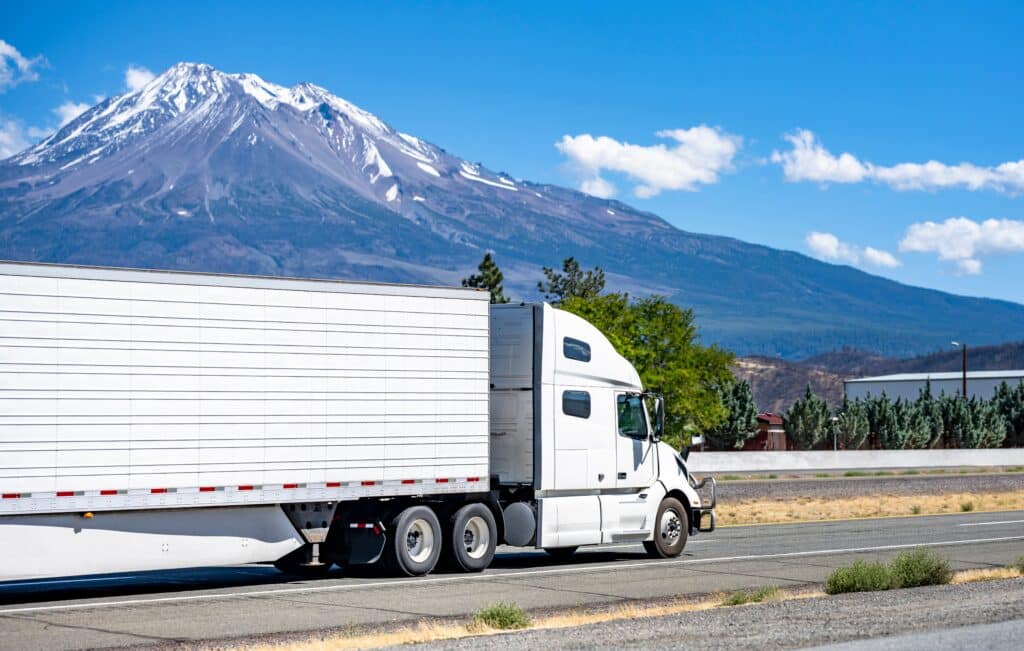
Beyond the Price Tag
Low-cost ELDs typically compromise in several critical areas:
- Hardware reliability. Budget devices often use lower-quality components that fail under harsh conditions. Connections loosen from vibration, screens crack from temperature changes, and batteries fail prematurely—each failure creating downtime and compliance risks.
- Software limitations. Inexpensive systems frequently run on outdated platforms that create operational inefficiencies. Slow interfaces waste valuable driving time, while poor synchronization between truck and office systems creates administrative headaches.
- Deceptive fee structures. Many budget providers advertise low monthly rates while building profit models around additional charges.
Real-World Consequences
These limitations translate into tangible business impacts:
- Compliance vulnerability. When ELDs malfunction during inspections, drivers face violations that impact safety scores and create financial penalties according to the electronic truck log mandate. A single out-of-service order can cost more than a year’s subscription to a quality electronic logbook.
- Productivity losses. Technical issues that delay deliveries directly impact revenue. Meanwhile, poor integration capabilities create duplicate work for office staff who must manually reconcile records across systems.
- Driver satisfaction. Professional drivers quickly grow frustrated with technology that complicates their already challenging job. In today’s competitive driver market, retention problems carry significant costs.
Evaluating Providers
When selecting an ELD, watch for these warning indicators:
- Vague compliance claims. Quality providers clearly state their registration status and regulatory compliance.
- Minimal support options. Reliable systems include effective support from staff familiar with trucking regulations.
- Restrictive contracts. Be wary of providers requiring long-term commitments with substantial termination penalties.
The lowest-priced ELD could not deliver the best value. By understanding both direct and indirect costs, you can select a system that supports compliance while enhancing rather than hindering your operations.
What Truckers Really Need in an ELD Beyond Compliance
Compliance is just the starting point for a truly effective ELD system. The best devices do more than satisfy FMCSA requirements—they actually make a driver’s workday easier and more productive. After years of ELD implementation, truckers have developed clear preferences about what features actually matter.
Essential Features That Improve Daily Operations
- Intuitive interface. The most valuable elog app feature is a simple, logical design that minimizes distraction. Drivers need systems they can operate with minimal interaction, allowing them to focus on the road rather than navigating complex menus.
- Flexibility in duty status. Quality ELDs make status changes straightforward, with easy corrections for common situations like yard moves and personal conveyance. This seemingly small feature can save hours of frustration each week.
- Automated documents. Leading systems automatically capture and organize supporting documents like fuel receipts and scale tickets, eliminating the paperwork shuffle that wastes precious off-duty time.
The Ease-of-Use Advantage
While manufacturers often promote advanced features, ease of use matters most in real-world operations. Here’s why:
- Training efficiency. Simpler systems require less training time, allowing drivers to become productive more quickly. This is particularly important given the industry’s turnover rates and regular onboarding needs.
- Reduced violations. Confusing interfaces lead to incorrect entries, which can trigger violations even when drivers are operating within legal limits. Clarity reduces compliance risks.
- Stress reduction. Driving a commercial vehicle is demanding enough without fighting technology. Intuitive systems reduce cognitive load, allowing drivers to focus on safety.
- Adaptation to experience levels. The trucking workforce spans multiple generations with varying technology comfort. Straightforward systems work for everyone from tech-savvy newcomers to experienced drivers who remember rotary phones.
The Support Factor: When Things Go Wrong
Perhaps nothing distinguishes dependable ELD providers more than what happens when problems arise. Superior providers deliver:
- Immediate assistance. Top ELD companies offer support with minimal hold times, recognizing that truckers operate around the clock and across time zones.
- Technical expertise. The best support teams understand both the technology and trucking regulations, providing solutions that keep drivers compliant even during system issues.
- Ongoing training. Leading companies provide continuous education about system updates and regulatory changes, ensuring drivers maintain compliance as requirements evolve.
The support experience often reveals a provider’s true priorities. Companies that invest in quality assistance demonstrate commitment to their customers’ operational success, not just selling devices.
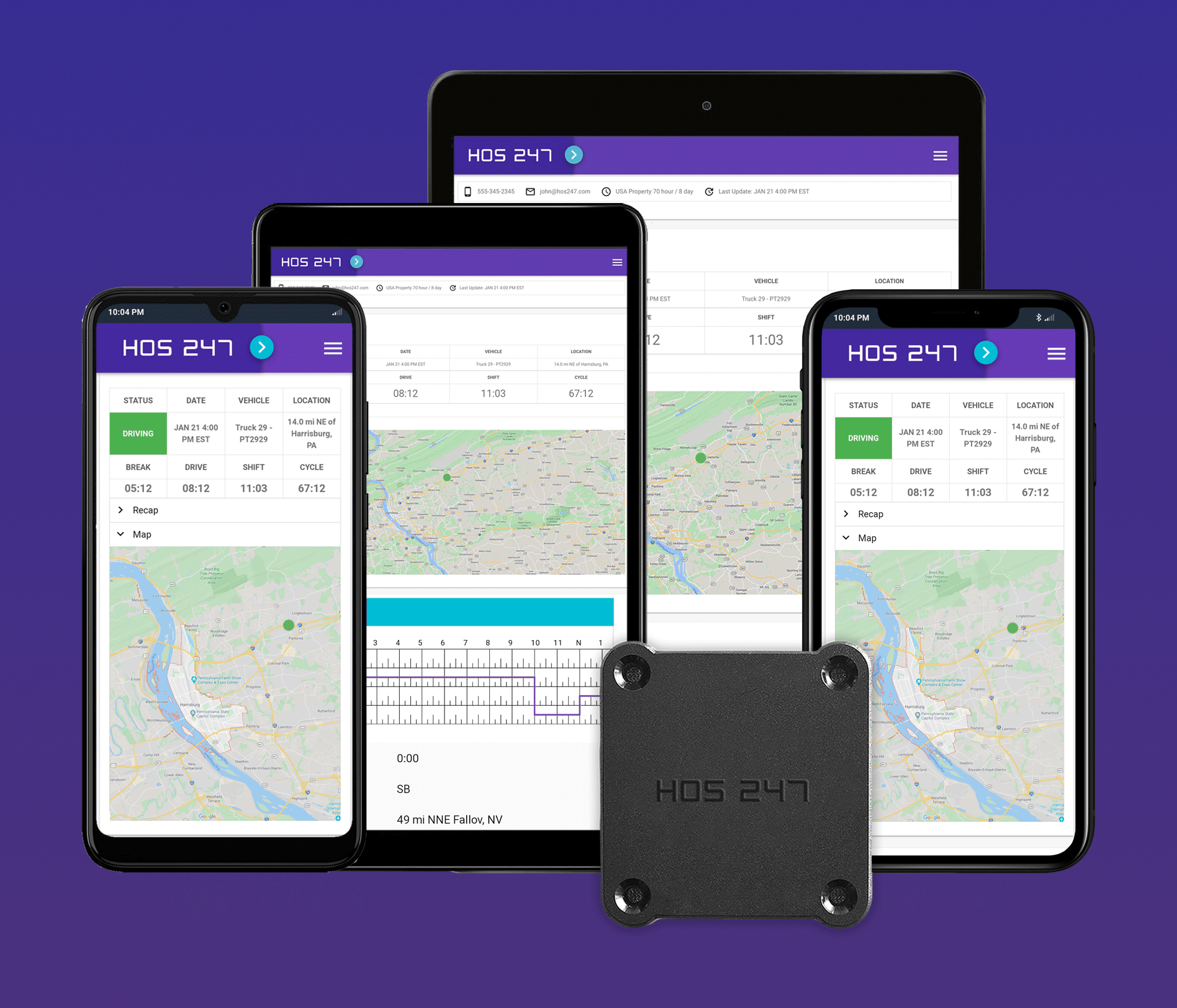
Why Many Truckers Switch to HOS247
As truckers have gained experience with electronic logging devices, many have found their current providers lacking in key areas like reliability, support, and pricing transparency. HOS247 has earned a reputation as a trusted alternative by addressing the most common frustrations drivers and fleet managers face.
- No long-term contracts. Unlike providers that lock customers into restrictive multi-year agreements with costly termination fees, HOS247 offers flexible month-to-month subscriptions. Fleets can adjust their plans as needed without financial penalties.
- Transparent pricing. HOS247 provides straightforward pricing with no hidden fees. The all-inclusive subscription model ensures customers know exactly what they’re paying for, avoiding unexpected charges on their monthly statements.
- Risk-free trial. A two-week trial period allows users to test the system in real-world conditions before making a commitment. This ensures compatibility with fleet operations and eliminates the risk of investing in an unsuitable solution.
- Reliable hardware. Our ELD maintains a strong Bluetooth connection, reducing lost data and reconnection issues. The durable design withstands the demanding conditions of long-haul trucking.
- User-friendly technology. The system is designed with truckers in mind, featuring a plug-and-play installation that takes less than 10 minutes. The intuitive interface works seamlessly on both Android and iOS devices, ensuring smooth operation for drivers of all experience levels.
- Multilingual customer support. We offer assistance in English, Spanish, Russian, and Polish, helping drivers communicate with support in their preferred language. Unlike many providers, HOS247 support is available seven days a week.
- Callback policy. If a driver’s support call is dropped due to poor signal, HOS247 representatives will call back instead of requiring them to restart the process. This reduces frustration and ensures timely issue resolution.
- Automatic compliance updates. HOS247 proactively updates its system to align with regulatory changes, keeping fleets compliant without requiring manual intervention from drivers or managers.
By prioritizing driver-friendly features, strong customer service, and flexible terms, HOS247 has become the go-to ELD provider for truckers looking for a reliable, stress-free solution.
The Future of Trucking Tech: What’s Next After ELDs?
Electronic logging devices represented just the beginning of trucking’s digital transformation. As the industry adapts to electronic logbooks, new technologies are already reshaping how freight moves across the country. Understanding these emerging trends helps forward-thinking drivers and fleet owners prepare for what’s coming.
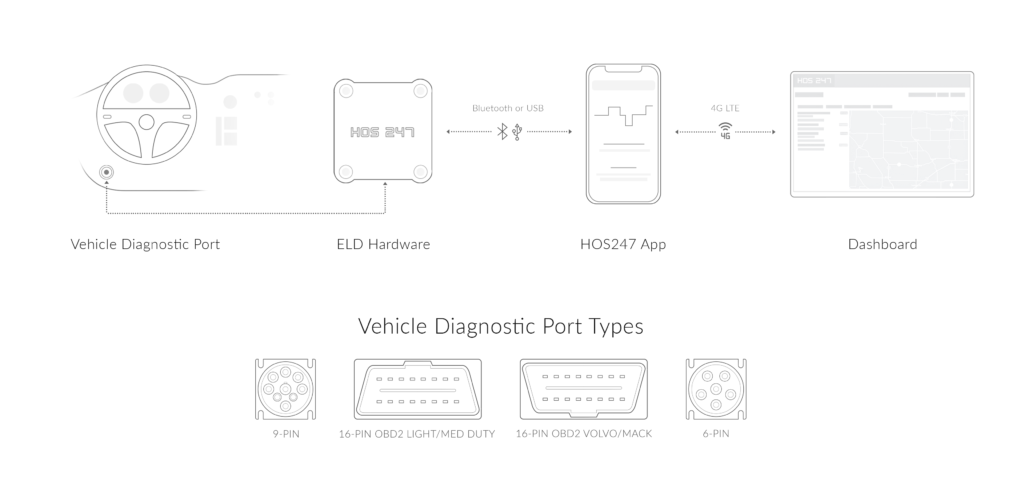
The Connected Truck Ecosystem
The modern truck is becoming an interconnected data hub. Beyond hours-of-service tracking, next-generation systems are integrating:
- Advanced telematics. Today’s telematics go far beyond location tracking, monitoring engine performance, fuel efficiency, and driver behaviors. These systems predict maintenance needs before breakdowns occur, potentially saving thousands in roadside repair costs.
- Real-time freight matching. Digital load boards are evolving into sophisticated matching systems that consider driver preferences, equipment specifications, and hours availability. These platforms reduce empty miles while helping drivers find better-paying freight that fits their schedule constraints.
- Dynamic routing. Enhanced GPS systems incorporate real-time data on weather, traffic, construction, and parking availability. These tools continuously recalculate optimal routes as conditions change, helping drivers maximize productive hours.
- Remote diagnostics. Manufacturers now build trucks with systems that communicate directly with service centers, providing detailed diagnostic information before the vehicle arrives for maintenance. This development reduces downtime by ensuring technicians and parts are ready.
AI and Automation in Trucking
Artificial intelligence is transforming trucking operations in ways that extend well beyond self-driving capabilities:
- Predictive analytics. AI systems analyze historical and real-time data to forecast traffic patterns, detention times at specific facilities, and optimal fuel purchase locations. These predictions help drivers make better decisions about routing and scheduling.
- Smart trailers. Trailers are becoming intelligent assets with their own sensor arrays monitoring cargo conditions, security status, and loading efficiency. These systems alert drivers to shifting loads, temperature fluctuations, or security breaches.
- Voice-assisted technology. Advanced voice recognition systems allow drivers to manage communications, navigation, and even ELD functions through natural speech, reducing distraction and improving safety.
While fully autonomous trucks remain on the horizon, partial automation features like adaptive cruise control, lane-keeping assistance, and automated emergency braking are already improving safety and reducing driver fatigue.
Preparing for the Next Five Years
The pace of technological change means drivers and fleet owners should prepare for significant shifts:
- Skills evolution. Technical proficiency will become increasingly valuable. Drivers who understand how to leverage technology will have advantages in productivity and earning potential.
- Data management. Owner-operators and small fleets will need strategies for managing the growing volume of operational data generated by their equipment.
- Investment planning. Technology adoption requires financial planning. Establishing upgrade budgets now helps avoid falling behind industry standards.
- Privacy considerations. As trucks collect more data, drivers should understand what information is being gathered and how it’s being used, particularly when it involves personal behaviors or biometrics.
The most successful professionals will be those who view technology as a partner rather than an intrusion, using these tools to enhance their skills rather than replace them.
Conclusion: Making ELDs Work for You
As electronic logging device mandate for trucks have become the industry standard, they’ve fundamentally changed trucking operations, creating both challenges and opportunities. While the transition hasn’t been seamless, the industry has adapted — and strategic drivers have found ways to leverage these systems beyond mere compliance.

The most successful operators use ELD data to improve planning, optimize hours, and reduce administrative work. They’ve transformed electronic logs from a regulatory burden into a business tool that provides documentation leverage with shippers and brokers while revealing operational patterns that guide better decisions.
When selecting an elog provider, compatibility with your specific operation matters more than flashy features. Look for companies that offer transparent pricing, continuous improvements, and genuine industry understanding. Providers like HOS247 have gained market share by addressing common pain points with flexible contracts, reliable technology, and responsive support.
As trucking continues its technological evolution, your choice of digital partners grows increasingly important. The trucking electronic log mandate may have begun as a government requirement, but forward-thinking professionals have discovered that the right implementation delivers benefits extending far beyond checking a regulatory box. By choosing systems that enhance rather than hinder your operation, you position yourself to thrive in an increasingly digital industry.

I’ve co-founded, built and managed several transportation-related businesses. Now, I’m a founder and CEO of HOS247 – an AI Transportation Platform for trucking companies, freight brokers and other logistics operations. We are transitioning old-style operations to technology-advanced logistics entities and help them to grow their businesses. ELDs (electronic logging devices), fleet tracking and management 2.0 combined with AI-powered dispatch tools.











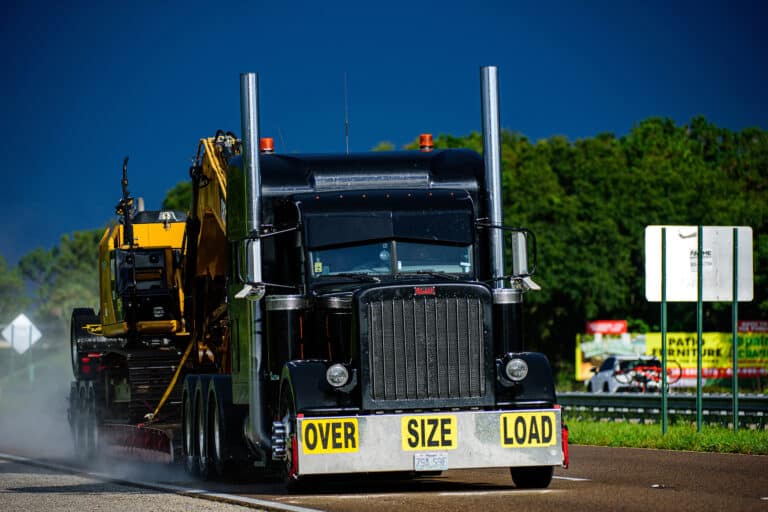
Truckers appreciate GPS fleet management systems for various reasons: workflow optimization and considerable cost savings are among the main arguments in their favor. Devices that offer real-time tracking help motor carriers gain complete control over their operations, increasing the security

Trucking businesses rely on ELD providers to stay DOT compliant. That is why choosing a reputable company with an efficient electronic log book for sale is so important. HOS247 offers an advanced elog solution that is FMCSA compliant, dependable, and
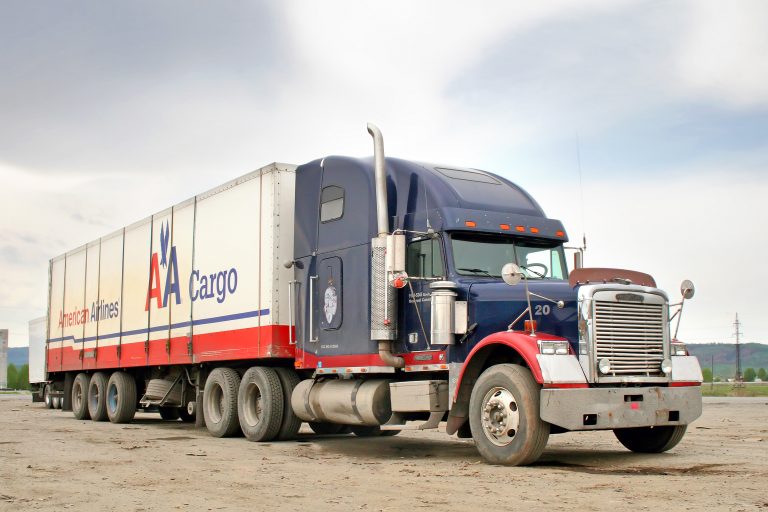
Ever since the ELD mandate was introduced by FMCSA, trucking companies and drivers are in a dilemma on how to choose the right provider. The e-log system has been mandated by the DOT to increase road safety and vehicle security.